Executive Summary
As the 2018 school season winds down and summer begins… it's time for the annual summer slowdown for most advisory firms, as client meetings get harder to schedule because they’re on vacation, and as advisors we ourselves have some time to relax with family... and catch up on good books.
As an avid book reader myself, I'm always eager to hear suggestions from others of great books to read, whether it's something new that's just come out, or an "old classic" that I should go back and read (again or for the first time!). And so, in the spirit of sharing, a few years ago I launched my list of "Recommended (Book) Reading for Financial Advisors", and it was so well received that in 2013 I also started sharing my annual "Summer Reading List" for financial advisors of the best books I'd read in the preceding year. It quickly became a perennial favorite on Nerd's Eye View, and so I've updated it every year, with new lists of books in 2014, 2015, 2016, and a fresh round last year in 2017.
And now, I'm now excited to share my latest 2018 Summer Reading list for financial advisors, with suggestions on books about everything from how to improve your financial advice so it actually “sticks” with clients, guidance on how to navigate your career path as a next generation “G2” advisor (or to hire one if you’re a firm owner looking to attract the next generation of talent), self-improvement books on how to better manage your productivity throughout the day or broader Principles to live and manage your life (and business), and an uplifting read on how the world continues to improve in amazing ways, and why the primary issue we face today is not the concerns of our political system or our economy or all the other dreadful drumbeats of negative news, but simply the ways that our own human instincts cause us to misinterpret (in a systematically negative way) the avalanche of information around us.
So as the summer season gets underway, I hope that you find this suggested summer reading list of books for financial planners to be helpful… and please do share your own suggestions in the comments at the end of the article about the best books you've read over the past year as well!
Financial Advisor Book List For 2018 Summer Reading
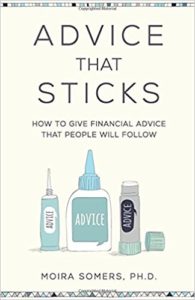 Advice That Sticks (Moira Somers) – A growing volume of behavioral finance research shows that, as Somers puts it, “most people are at least mildly crazy when it comes to money.” For individuals who are trying to be responsible with their money, that represents a substantial challenge. For financial advisors who are trying to help people with their money, it’s arguably an even greater challenge, as clients not only struggle to make rational decisions with their money in the first place, but can be influenced by a wide range of other factors, from the quality of the advisor’s relationship with their clients, to their style of communication, and even the setup of the office they’re meeting in. And unfortunately, while most financial advisors receive extensive technical training in their studies for CFP certification on everything from tax law to investment theory, there is little taught about how to actually communicate and deliver the subsequent planning recommendations in a way that makes clients most likely to actually implement them. Accordingly, in her book, Dr. Somers explores the dynamics of what it takes to deliver advice that actually “sticks” – in other words, how to actually be a good advice-giver in the first place, drawing heavily on the research from other domains (e.g., what doctors must do to help patients quit smoking or take their medications), applied to the world of financial advisors. The starting point to reducing “non-adherence” (where clients don’t take the advisor’s advice) is simply to recognize why people seek advice in the first place – and the fact that in an increasingly technology-driven world (that puts an immense amount of information right at our fingertips), it’s rarely about just accessing expert knowledge anymore, and instead is usually about something more nuances like reducing complexity, saving time, finding help to actually take action, or simply offloading unpleasant decisions we don’t want to feel responsible for (which matters, because the nature of what they are seeking influences the best way to deliver the recommendations to them!). From there, Somers explores the delicate balance between educating clients (to lift them up) and making them feel stupid (which can be very demotivating!), why it’s important not to be too overly confident in recommendations (and risk overlooking important nuances of the client’s situation) but not too empathetic either (or risk being “too soft” and not pushing enough for clients to make changes they need to make), and why some types of advice are harder to take than others (e.g., simple short-term goals are easier to implement than long-term lifestyle changes). But ultimately, the key point is simply to recognize that it’s no longer enough to say “I gave the right advice, and it’s the client’s problem if they don’t implement it”; instead, clients who fail to implement are at least sometimes a reflection of the financial advisor’s failure to deliver the advice in an effective way, for which Dr. Somers’ “Advice That Sticks” is aiming to close the gap!
Advice That Sticks (Moira Somers) – A growing volume of behavioral finance research shows that, as Somers puts it, “most people are at least mildly crazy when it comes to money.” For individuals who are trying to be responsible with their money, that represents a substantial challenge. For financial advisors who are trying to help people with their money, it’s arguably an even greater challenge, as clients not only struggle to make rational decisions with their money in the first place, but can be influenced by a wide range of other factors, from the quality of the advisor’s relationship with their clients, to their style of communication, and even the setup of the office they’re meeting in. And unfortunately, while most financial advisors receive extensive technical training in their studies for CFP certification on everything from tax law to investment theory, there is little taught about how to actually communicate and deliver the subsequent planning recommendations in a way that makes clients most likely to actually implement them. Accordingly, in her book, Dr. Somers explores the dynamics of what it takes to deliver advice that actually “sticks” – in other words, how to actually be a good advice-giver in the first place, drawing heavily on the research from other domains (e.g., what doctors must do to help patients quit smoking or take their medications), applied to the world of financial advisors. The starting point to reducing “non-adherence” (where clients don’t take the advisor’s advice) is simply to recognize why people seek advice in the first place – and the fact that in an increasingly technology-driven world (that puts an immense amount of information right at our fingertips), it’s rarely about just accessing expert knowledge anymore, and instead is usually about something more nuances like reducing complexity, saving time, finding help to actually take action, or simply offloading unpleasant decisions we don’t want to feel responsible for (which matters, because the nature of what they are seeking influences the best way to deliver the recommendations to them!). From there, Somers explores the delicate balance between educating clients (to lift them up) and making them feel stupid (which can be very demotivating!), why it’s important not to be too overly confident in recommendations (and risk overlooking important nuances of the client’s situation) but not too empathetic either (or risk being “too soft” and not pushing enough for clients to make changes they need to make), and why some types of advice are harder to take than others (e.g., simple short-term goals are easier to implement than long-term lifestyle changes). But ultimately, the key point is simply to recognize that it’s no longer enough to say “I gave the right advice, and it’s the client’s problem if they don’t implement it”; instead, clients who fail to implement are at least sometimes a reflection of the financial advisor’s failure to deliver the advice in an effective way, for which Dr. Somers’ “Advice That Sticks” is aiming to close the gap!
[Tweet "Do advisors have a responsibility to figure out how to deliver 'advice that sticks'?"]
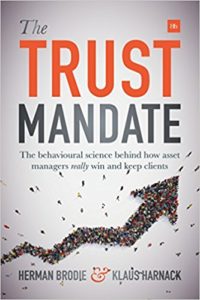 The Trust Mandate (Herman Brodie & Klaus Harnack) – In a rational and efficient market, capital flows to the investments that present the greatest opportunity, or at least to the investment managers who are expected to be able to select them. Yet in practice, there is a surprising persistence of not only investment managers retaining client assets even in the midst of extended periods of sub-par performance, but even in their ability to attract assets despite having inferior investment performance in the first place. In this book, the authors explore why, both by “following the money” with quantitative analysis of fund flows, and by using qualitative research that asked institutional investment consultants why they often chose (or stuck with) managers who didn’t have the best performance – and find that the answer is “trust”, and specifically that advisors/consultants (and investors themselves) who select managers place a significant weighting not just on the manager’s results but the manager’s trustworthiness that leads to an expectation about whether (or not) they can deliver results in the future. In fact, trust is so powerful in asset management, that researchers have found lower levels of trust are associated with less efficient markets in the first place, as investors literally don’t trust that earnings announcements are legitimate and therefore prices respond more slowly. Notably, while the book is written primarily in the context of how institutional consultants choose investment managers, it nonetheless has relevance for financial advisors as well, especially the later chapters that explore what it is that actually creates trust – a combination of competence (is the advisor competent enough to deliver the desired results), and what the authors call “warmth” (in essence, a demonstration of whether the advisor actually cares about the client). After all, those who are warm and kind but not competent we tend to pity, while those who are competent but not kind will at best attract our envy (but not our admiration); it’s only the combination of the two that engenders trust. To some extent, this isn’t entirely surprising, and just reinforces the old industry saying “Clients don’t care what you know until they know that you care.” But from a practical perspective, it’s a powerful reminder that it’s truly not enough to demonstrate your competency and expertise as a financial advisor, until/unless you also demonstrate that you actually care about your clients and their outcomes. And notably, the Trust Mandate research also suggests that one of the benefits of a prospective fiduciary rule is that by increasing the legal bar to act in client’s best interests, the industry may actually gain trust as a whole (just as the aforementioned “anomaly” of low-trust companies’ stock prices not responding to earnings announcements vanished once Sarbanes-Oxley created an assurance in the minds of investors that earnings announcements could be trusted in the future).
The Trust Mandate (Herman Brodie & Klaus Harnack) – In a rational and efficient market, capital flows to the investments that present the greatest opportunity, or at least to the investment managers who are expected to be able to select them. Yet in practice, there is a surprising persistence of not only investment managers retaining client assets even in the midst of extended periods of sub-par performance, but even in their ability to attract assets despite having inferior investment performance in the first place. In this book, the authors explore why, both by “following the money” with quantitative analysis of fund flows, and by using qualitative research that asked institutional investment consultants why they often chose (or stuck with) managers who didn’t have the best performance – and find that the answer is “trust”, and specifically that advisors/consultants (and investors themselves) who select managers place a significant weighting not just on the manager’s results but the manager’s trustworthiness that leads to an expectation about whether (or not) they can deliver results in the future. In fact, trust is so powerful in asset management, that researchers have found lower levels of trust are associated with less efficient markets in the first place, as investors literally don’t trust that earnings announcements are legitimate and therefore prices respond more slowly. Notably, while the book is written primarily in the context of how institutional consultants choose investment managers, it nonetheless has relevance for financial advisors as well, especially the later chapters that explore what it is that actually creates trust – a combination of competence (is the advisor competent enough to deliver the desired results), and what the authors call “warmth” (in essence, a demonstration of whether the advisor actually cares about the client). After all, those who are warm and kind but not competent we tend to pity, while those who are competent but not kind will at best attract our envy (but not our admiration); it’s only the combination of the two that engenders trust. To some extent, this isn’t entirely surprising, and just reinforces the old industry saying “Clients don’t care what you know until they know that you care.” But from a practical perspective, it’s a powerful reminder that it’s truly not enough to demonstrate your competency and expertise as a financial advisor, until/unless you also demonstrate that you actually care about your clients and their outcomes. And notably, the Trust Mandate research also suggests that one of the benefits of a prospective fiduciary rule is that by increasing the legal bar to act in client’s best interests, the industry may actually gain trust as a whole (just as the aforementioned “anomaly” of low-trust companies’ stock prices not responding to earnings announcements vanished once Sarbanes-Oxley created an assurance in the minds of investors that earnings announcements could be trusted in the future).
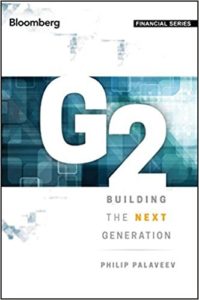 G2: The Next Generation (Philip Palaveev) – Historically, the career path for the financial advisor was to start out selling insurance or investment products, and over time grow the business to the point that it was feasible to study for CFP certification and expand into more comprehensive financial planning. Over the past 20 years, though, the rise of the AUM model – and its recurring revenue – has made it possible to grow and scale financial advisory firms by hiring employee advisors whose sole job is simply to service existing clients… to the point that now, industry benchmarking studies show there are more employee advisors than advisory firm owners in the RIA channel! As a result, career success as a financial advisor isn’t necessarily about one’s ability to do sales and business development from day 1, but to navigate the dynamics of trying to climb the ladder to become a partner at an advisory firm… for which there is no guide on how to do it. Until now. Because in his latest book “G2: The Next Generation”, Palaveev has effectively written the handbook for next generation financial advisors trying to figure out how to navigate the career tracks of a larger firm, from the skills that must be developed over time (from how to command credibility as a young advisor by narrowing your focus to a domain where you can establish yourself as an expert, to mastering the four tiers of technical competency, relationships, business development, and management skills), to the dynamics of managing work/life balance as a young advisor that may be both starting a family and trying to build a career, the way to think about the potential opportunity to buy into a firm, and the reality that because so few advisory firms have fully established their own career tracks, most next generation advisors will need to learn to “manage up” to the firm’s founders… because in the real world, it’s not always enough to just try to be a “good” advisor and wait and hope for the firm to recognize your contributions to the firm. Simply put, “G2: The Next Generation” should be required reading for any new (or experienced) financial advisor who is looking to advance their own career in a larger advisory firm, and especially any advisor who someday hopes to reach a leadership (and partnership) position themselves!
G2: The Next Generation (Philip Palaveev) – Historically, the career path for the financial advisor was to start out selling insurance or investment products, and over time grow the business to the point that it was feasible to study for CFP certification and expand into more comprehensive financial planning. Over the past 20 years, though, the rise of the AUM model – and its recurring revenue – has made it possible to grow and scale financial advisory firms by hiring employee advisors whose sole job is simply to service existing clients… to the point that now, industry benchmarking studies show there are more employee advisors than advisory firm owners in the RIA channel! As a result, career success as a financial advisor isn’t necessarily about one’s ability to do sales and business development from day 1, but to navigate the dynamics of trying to climb the ladder to become a partner at an advisory firm… for which there is no guide on how to do it. Until now. Because in his latest book “G2: The Next Generation”, Palaveev has effectively written the handbook for next generation financial advisors trying to figure out how to navigate the career tracks of a larger firm, from the skills that must be developed over time (from how to command credibility as a young advisor by narrowing your focus to a domain where you can establish yourself as an expert, to mastering the four tiers of technical competency, relationships, business development, and management skills), to the dynamics of managing work/life balance as a young advisor that may be both starting a family and trying to build a career, the way to think about the potential opportunity to buy into a firm, and the reality that because so few advisory firms have fully established their own career tracks, most next generation advisors will need to learn to “manage up” to the firm’s founders… because in the real world, it’s not always enough to just try to be a “good” advisor and wait and hope for the firm to recognize your contributions to the firm. Simply put, “G2: The Next Generation” should be required reading for any new (or experienced) financial advisor who is looking to advance their own career in a larger advisory firm, and especially any advisor who someday hopes to reach a leadership (and partnership) position themselves!
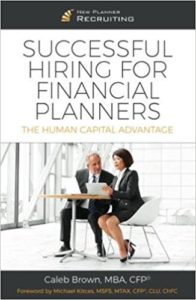 Successful Hiring For Financial Planners (Caleb Brown) – The rise of the employee advisor and the shift towards paraplanners and associate advisors as the entry pathway to a financial advisor career hasn’t only been a challenge for next generation advisors trying to figure out the best way to navigate their career path. It’s also been a challenge to growing advisory firms, especially solo advisors and small partnerships, that are trying to figure out the right steps to take to hire their first paraplanner or associate planner in the first place… in a world where historically, advisors tended to only hire administrative and operations staff (if anyone at all), and not younger/newer advisors to come into a professional career track. Accordingly, in his new book, Caleb Brown of New Planner Recruiting shares his tips and best practices for firm owners that are trying to figure out how to go about the hiring process (especially for the first time), from where to source potential hires (from Job Boards to college campuses), the trade-offs between hiring new college grads or career changes, the importance of crafting a compelling job description to attract top talent (including a Sample you can use), how to run a candidate interview (with sample interview agenda), how to screen candidates using assessment tools like Kolbe and work samples to evaluate competency, and perspective on understanding the next generation of financial advisors (i.e., Gen Y Millennials and the iGen that’s following them) and what they really want and the kinds of jobs the best are attracted to.
Successful Hiring For Financial Planners (Caleb Brown) – The rise of the employee advisor and the shift towards paraplanners and associate advisors as the entry pathway to a financial advisor career hasn’t only been a challenge for next generation advisors trying to figure out the best way to navigate their career path. It’s also been a challenge to growing advisory firms, especially solo advisors and small partnerships, that are trying to figure out the right steps to take to hire their first paraplanner or associate planner in the first place… in a world where historically, advisors tended to only hire administrative and operations staff (if anyone at all), and not younger/newer advisors to come into a professional career track. Accordingly, in his new book, Caleb Brown of New Planner Recruiting shares his tips and best practices for firm owners that are trying to figure out how to go about the hiring process (especially for the first time), from where to source potential hires (from Job Boards to college campuses), the trade-offs between hiring new college grads or career changes, the importance of crafting a compelling job description to attract top talent (including a Sample you can use), how to run a candidate interview (with sample interview agenda), how to screen candidates using assessment tools like Kolbe and work samples to evaluate competency, and perspective on understanding the next generation of financial advisors (i.e., Gen Y Millennials and the iGen that’s following them) and what they really want and the kinds of jobs the best are attracted to.
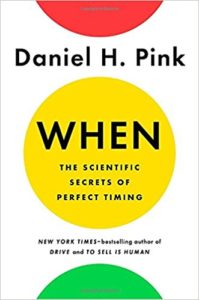 When: The Scientific Secret of Perfect Timing (Daniel Pink) – Nearly 300 years ago, scientist Jean-Jacques d’Ortous de Mairan first discovered that plants have an internal “biological clock”, a phenomenon that it turns out is true of virtually every living thing from single-cell organisms to complex human beings. And it turns out these circadian rhythms impact everything from when our bodies naturally want to go to sleep and wake up, to the rise and fall of our moods throughout the day, and also our creativity and mental productivity. In fact, most people reach their peak alertness and productive energy levels in the late morning, which then plummets in the afternoon, before recovering slightly in the evening… although in point of fact, that low point of alertness in the afternoon is also our peak moment of creativity! (Except for a subset of us have the “night owl” chronotype, and really do tend to wake up later, go to sleep later, and therefore hit our peak productivity and peak creativity at later times in the day.) In his book “When”, Pink explores the research on this and other factors of timing, to help better understand when it’s best to schedule various analytical, creative, or social engagements throughout the day (based on our natural cycle of peak, trough, and recovery), the impact of timely responsiveness (as it turns out, your email response time is the single best predictor of whether your employees are satisfied with you), the optimal timing of everything from exercise to taking breaks to getting married, and how timing impacts us throughout our lives in the so-called U-curve of happiness (that we are happy in our early adult years, become less happy in our late 40s and early 50s, and then experience rising happiness again into our elder years). And for those who want to explore how to apply this time-based research and related techniques to themselves, Pink includes a “Time Hacker’s Handbook” – a series of tips and tools at the end of each chapter to apply the concepts to your own life, starting with this chronotype test to understand whether you are a night owl, a lark (early riser), or a ‘third bird’ (those who are neither very early nor very late risers).
When: The Scientific Secret of Perfect Timing (Daniel Pink) – Nearly 300 years ago, scientist Jean-Jacques d’Ortous de Mairan first discovered that plants have an internal “biological clock”, a phenomenon that it turns out is true of virtually every living thing from single-cell organisms to complex human beings. And it turns out these circadian rhythms impact everything from when our bodies naturally want to go to sleep and wake up, to the rise and fall of our moods throughout the day, and also our creativity and mental productivity. In fact, most people reach their peak alertness and productive energy levels in the late morning, which then plummets in the afternoon, before recovering slightly in the evening… although in point of fact, that low point of alertness in the afternoon is also our peak moment of creativity! (Except for a subset of us have the “night owl” chronotype, and really do tend to wake up later, go to sleep later, and therefore hit our peak productivity and peak creativity at later times in the day.) In his book “When”, Pink explores the research on this and other factors of timing, to help better understand when it’s best to schedule various analytical, creative, or social engagements throughout the day (based on our natural cycle of peak, trough, and recovery), the impact of timely responsiveness (as it turns out, your email response time is the single best predictor of whether your employees are satisfied with you), the optimal timing of everything from exercise to taking breaks to getting married, and how timing impacts us throughout our lives in the so-called U-curve of happiness (that we are happy in our early adult years, become less happy in our late 40s and early 50s, and then experience rising happiness again into our elder years). And for those who want to explore how to apply this time-based research and related techniques to themselves, Pink includes a “Time Hacker’s Handbook” – a series of tips and tools at the end of each chapter to apply the concepts to your own life, starting with this chronotype test to understand whether you are a night owl, a lark (early riser), or a ‘third bird’ (those who are neither very early nor very late risers).
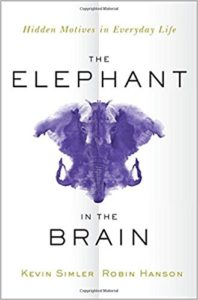 The Elephant In The Brain (Kevin Simler and Robin Hanson) – Humans are highly social animals. Our brains have evolved in a manner that is constantly monitoring our social surroundings, allowing us to seek opportunities and avoid threats in our environment. However, one often overlooked way in which our brains can help us succeed socially is by ignoring certain motivations, particularly when those motivations may be selfish in nature or otherwise inconsistent with how we want to view ourselves. This is the "elephant in the brain" – the ways in which we use deception and self-deception to blind ourselves and others of our true motivations and get ahead socially. Through a careful examination of a wide range of human behavior – from foundational human behaviors such as body language and conversation, to more specific applications in areas such as consumption, art, charity, and medicine – author Kevin Simler and economist Robin Hanson aim to shine a spotlight on some of our hidden motivations underlying our behavior. For instance, though many of our motivations around healthcare stem from a genuine desire to promote health and well-being, Simler and Hanson argue that there is actually much more going on. Like the mother who kisses a child's scraped knee (which has no therapeutic value despite the fact that both parties enjoy the practice... the child feeling cared for and the mother feeling good comforting her child), the authors argue that a considerable portion of modern medicine is "conspicuous care" that is part of a more elaborate grown-up version of "kiss the boo boo". Ultimately, exploring our hidden motives can be a bit uncomfortable (that's why we like to keep them hidden in the first place), but a clearer understanding what drives behavior can help both promote good behavior among clients (e.g., understanding why a client's words may not align with their actions), and promote the success of financial advisors (e.g., by ensuring that the signals we may be consciously or unconsciously sending to prospects and clients are conveying the messages we actually want to get across).
The Elephant In The Brain (Kevin Simler and Robin Hanson) – Humans are highly social animals. Our brains have evolved in a manner that is constantly monitoring our social surroundings, allowing us to seek opportunities and avoid threats in our environment. However, one often overlooked way in which our brains can help us succeed socially is by ignoring certain motivations, particularly when those motivations may be selfish in nature or otherwise inconsistent with how we want to view ourselves. This is the "elephant in the brain" – the ways in which we use deception and self-deception to blind ourselves and others of our true motivations and get ahead socially. Through a careful examination of a wide range of human behavior – from foundational human behaviors such as body language and conversation, to more specific applications in areas such as consumption, art, charity, and medicine – author Kevin Simler and economist Robin Hanson aim to shine a spotlight on some of our hidden motivations underlying our behavior. For instance, though many of our motivations around healthcare stem from a genuine desire to promote health and well-being, Simler and Hanson argue that there is actually much more going on. Like the mother who kisses a child's scraped knee (which has no therapeutic value despite the fact that both parties enjoy the practice... the child feeling cared for and the mother feeling good comforting her child), the authors argue that a considerable portion of modern medicine is "conspicuous care" that is part of a more elaborate grown-up version of "kiss the boo boo". Ultimately, exploring our hidden motives can be a bit uncomfortable (that's why we like to keep them hidden in the first place), but a clearer understanding what drives behavior can help both promote good behavior among clients (e.g., understanding why a client's words may not align with their actions), and promote the success of financial advisors (e.g., by ensuring that the signals we may be consciously or unconsciously sending to prospects and clients are conveying the messages we actually want to get across).
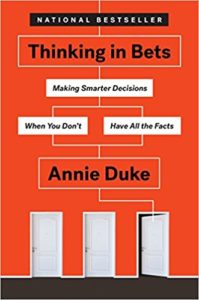 Thinking In Bets (Annie Duke) – Entrepreneur and venture capitalist Peter Thiel has famously argued that statistics provides a much better foundation for real-world thanking than calculus. The reason being that in the real world (and particularly the business world) a statistical mindset is better aligned with the inherent uncertainties that we face. In "Thinking In Bets", Annie Duke, a former World Series of Poker Champion, provides practical guidance on making better decisions through statistical thinking. For instance, Duke examines why it is important to separate "bad outcomes" from "bad decisions" (because even perfectly sound forecasts will occasionally not pan out in our favor), why most of the bets we make are actually bets against ourselves (e.g., whether we should adopt one marketing strategy or another), how intelligence can actually make us even more susceptible to behavioral biases (as it becomes easier to craft a plausible narratives that justify the conclusions we are motivated to reach), and many other business decisions ultimately grounded in statistical considerations. In the end, "Thinking In Bets" provides useful takeaways for both advisors helping clients make important financial and life decisions, as well as advisors applying the lessons in order to build more successful practices.
Thinking In Bets (Annie Duke) – Entrepreneur and venture capitalist Peter Thiel has famously argued that statistics provides a much better foundation for real-world thanking than calculus. The reason being that in the real world (and particularly the business world) a statistical mindset is better aligned with the inherent uncertainties that we face. In "Thinking In Bets", Annie Duke, a former World Series of Poker Champion, provides practical guidance on making better decisions through statistical thinking. For instance, Duke examines why it is important to separate "bad outcomes" from "bad decisions" (because even perfectly sound forecasts will occasionally not pan out in our favor), why most of the bets we make are actually bets against ourselves (e.g., whether we should adopt one marketing strategy or another), how intelligence can actually make us even more susceptible to behavioral biases (as it becomes easier to craft a plausible narratives that justify the conclusions we are motivated to reach), and many other business decisions ultimately grounded in statistical considerations. In the end, "Thinking In Bets" provides useful takeaways for both advisors helping clients make important financial and life decisions, as well as advisors applying the lessons in order to build more successful practices.
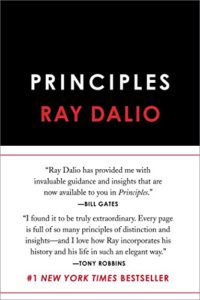 Principles (Ray Dalio) – Ray Dalio is the founder and chairman of Bridgewater Associates, the largest hedge fund in the world, and success has vaulted him to become one of the top 100 wealthiest individuals in the world. Yet Dalio’s firm is unique not merely for its incredible financial success, but also because of the unique “Principles” by which the firm is run, including a form of radical candor where employees even have an app to rate other employees’ arguments in real time. Yet at the core of Dalio’s Principles is simply an exploration of how important it is to be open and willing to take sometimes harsh criticism and tough love on the path to self-improvement – a lesson that Dalio himself has learned (and shares with poignant examples). Principles also includes both a telling of Dalio’s own autobiographical story of his early career, starting Bridgewater, nearly going broke in the early years, being confronted by his “lieutenant” managers about his failings, and subsequently recovering to build the $160B firm that Bridgewater is today. But ultimately, most advisors will likely be drawn to the later sections of the (rather long, 600-page) book, that detail both Dalio’s Principles themselves, and how he applies them to both his life, and has used them to create (sometimes highly controversial) systems within his business, all built around the core first principle that everyone should first figure out: 1) what do you want?; 2) what is true?; and 3) what are you going to do about it? Though arguably, Dalio’s Principles will be much more effective and relevant for those who have a clear understanding on what their long-term goals actually are in the first place, and want a system of principles to pursue them (and if not, fall back to one of Dalio’s other core principles: “Have clear goals”!).
Principles (Ray Dalio) – Ray Dalio is the founder and chairman of Bridgewater Associates, the largest hedge fund in the world, and success has vaulted him to become one of the top 100 wealthiest individuals in the world. Yet Dalio’s firm is unique not merely for its incredible financial success, but also because of the unique “Principles” by which the firm is run, including a form of radical candor where employees even have an app to rate other employees’ arguments in real time. Yet at the core of Dalio’s Principles is simply an exploration of how important it is to be open and willing to take sometimes harsh criticism and tough love on the path to self-improvement – a lesson that Dalio himself has learned (and shares with poignant examples). Principles also includes both a telling of Dalio’s own autobiographical story of his early career, starting Bridgewater, nearly going broke in the early years, being confronted by his “lieutenant” managers about his failings, and subsequently recovering to build the $160B firm that Bridgewater is today. But ultimately, most advisors will likely be drawn to the later sections of the (rather long, 600-page) book, that detail both Dalio’s Principles themselves, and how he applies them to both his life, and has used them to create (sometimes highly controversial) systems within his business, all built around the core first principle that everyone should first figure out: 1) what do you want?; 2) what is true?; and 3) what are you going to do about it? Though arguably, Dalio’s Principles will be much more effective and relevant for those who have a clear understanding on what their long-term goals actually are in the first place, and want a system of principles to pursue them (and if not, fall back to one of Dalio’s other core principles: “Have clear goals”!).
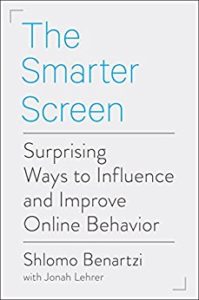 The Smarter Screen (Shlomo Benartzi & Jonah Lehrer) – The good news about the rise of the internet is that human beings have never had more information accessible to them. The bad news is that our brains haven’t altered the ways that we take in that information, though. The end result is that we effectively “drown” in a deluge of information… for which technology, and in particular the computer (and now smartphone/tablet) screens we look at, are not only our pathway to the information, but also the filters that can drastically impact how we take in and interpret the information. As the saying goes, “a wealth of information creates a poverty of attention”, which in turn means that the ability of computer screens to not just provide access to information, but help us to focus our attention, becomes especially valuable. Unfortunately, though, the fact that how our screens present information to us can influence what we pay attention to, and therefore what we value, and even the decisions we make, means there is an immense amount of consequence to how, exactly, computer screens present information to us. Especially since a growing base of research suggests that when it comes to taking in information via computer screen, we are even more “scatterbrained” than we are when reading it on paper. According, Benartzi and Lehrer’s book explores all the ways that our brains struggle to figure out what to focus on, how the ways that information is presented to us on computers screens alters or impacts that focus, and how that information – including financial information – can be presented to us via computer screens in ways that positively impact behavior. In fact, the authors note a study that was done with the personal financial management app Personal Capital, which uses account aggregation to help individuals track their own spending… and found that by merely effectively presenting that information back to consumers, the average person decreased their spending by a whopping 15.7% in just 4 months! Which suggests that the entire future of financial planning could have a heavy technology component that helps people use and leverage their computer screens (and smartphones) in positive ways to improve their financial behavior!
The Smarter Screen (Shlomo Benartzi & Jonah Lehrer) – The good news about the rise of the internet is that human beings have never had more information accessible to them. The bad news is that our brains haven’t altered the ways that we take in that information, though. The end result is that we effectively “drown” in a deluge of information… for which technology, and in particular the computer (and now smartphone/tablet) screens we look at, are not only our pathway to the information, but also the filters that can drastically impact how we take in and interpret the information. As the saying goes, “a wealth of information creates a poverty of attention”, which in turn means that the ability of computer screens to not just provide access to information, but help us to focus our attention, becomes especially valuable. Unfortunately, though, the fact that how our screens present information to us can influence what we pay attention to, and therefore what we value, and even the decisions we make, means there is an immense amount of consequence to how, exactly, computer screens present information to us. Especially since a growing base of research suggests that when it comes to taking in information via computer screen, we are even more “scatterbrained” than we are when reading it on paper. According, Benartzi and Lehrer’s book explores all the ways that our brains struggle to figure out what to focus on, how the ways that information is presented to us on computers screens alters or impacts that focus, and how that information – including financial information – can be presented to us via computer screens in ways that positively impact behavior. In fact, the authors note a study that was done with the personal financial management app Personal Capital, which uses account aggregation to help individuals track their own spending… and found that by merely effectively presenting that information back to consumers, the average person decreased their spending by a whopping 15.7% in just 4 months! Which suggests that the entire future of financial planning could have a heavy technology component that helps people use and leverage their computer screens (and smartphones) in positive ways to improve their financial behavior!
[Tweet "Better presentation of spending information led to reductions of over 15% in just 4 months!"]
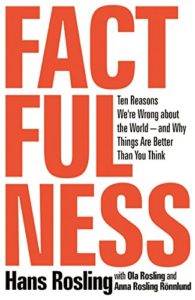 Factfulness: Ten Reasons We’re Wrong About The World (Hans Rosling) – One of the fundamental challenges of the modern era of technology is that “bad news sells”, which means digital publications and social media tend to propagate bad news faster and further than good news… which can quickly lead to the impression that the world is quickly going to hell. In fact, Rosling has found in his own research, polling nearly 12,000 people across 14 countries for their understanding of world progress, that not only is virtually no one aware of what’s actually happening, but most are systematically wrong due to our negativity bias and other instincts that distort our worldview, such that we actually score worse than random chance when asked questions about global poverty, access to medicine, and climate change! Yet the reality is that actually, the world has been undergoing drastic positive changes over the past several decades; for instance, in just the past 20 years, the proportion of the global population in extreme poverty has been cut in half, and we are rapidly growing both wealthier and healthier as both GDP per capita and life expectancies improve around the world, and paradoxically the rising wealth and improving health around the world may actually slow the population growth of the world (as while greater wealth makes it affordable to have more children, average family sizes tend to shrink once access to medical care improves and child mortality rates decline). Ultimately, Rosling provides a new and unique way of looking at the world, separating the global population not into “poor” and “rich” countries but four levels of income (from those in extreme poverty who spend most of their time walking barefoot to get water, to the largest segment that are ‘poor’ but at least can buy shoes or a bike and send their children to school, to the moderately affluent who have access to running water and a refrigerator, and the billion people who are able to achieve a high school education and occasionally take a vacation), and exploring how we can overcome our natural instincts and biases to take a more objective and fact-based view of what an amazing and rapidly improving world we really live in.
Factfulness: Ten Reasons We’re Wrong About The World (Hans Rosling) – One of the fundamental challenges of the modern era of technology is that “bad news sells”, which means digital publications and social media tend to propagate bad news faster and further than good news… which can quickly lead to the impression that the world is quickly going to hell. In fact, Rosling has found in his own research, polling nearly 12,000 people across 14 countries for their understanding of world progress, that not only is virtually no one aware of what’s actually happening, but most are systematically wrong due to our negativity bias and other instincts that distort our worldview, such that we actually score worse than random chance when asked questions about global poverty, access to medicine, and climate change! Yet the reality is that actually, the world has been undergoing drastic positive changes over the past several decades; for instance, in just the past 20 years, the proportion of the global population in extreme poverty has been cut in half, and we are rapidly growing both wealthier and healthier as both GDP per capita and life expectancies improve around the world, and paradoxically the rising wealth and improving health around the world may actually slow the population growth of the world (as while greater wealth makes it affordable to have more children, average family sizes tend to shrink once access to medical care improves and child mortality rates decline). Ultimately, Rosling provides a new and unique way of looking at the world, separating the global population not into “poor” and “rich” countries but four levels of income (from those in extreme poverty who spend most of their time walking barefoot to get water, to the largest segment that are ‘poor’ but at least can buy shoes or a bike and send their children to school, to the moderately affluent who have access to running water and a refrigerator, and the billion people who are able to achieve a high school education and occasionally take a vacation), and exploring how we can overcome our natural instincts and biases to take a more objective and fact-based view of what an amazing and rapidly improving world we really live in.
If you’re still looking for more book ideas, be certain to also check out our prior summer reading lists, along with our overall list of recommended books for financial advisors. They may be lists we've published in the past, but if you haven’t read the books yet, they're still new to you! 🙂
Top Must-Read Books for Financial Planners
2017 Summer Reading List of “Best Books” For Financial Advisors
2016 Summer Reading List of “Best Books” For Financial Advisors
2015 Summer Book List For Financial Advisors
2014 Summer Reading List Of Best Books For Financial Advisors
2013 Summer Reading List Of Top Financial Advisor Books
So what do you think? Will you be reading any of these books over the summer? Do you have any suggestions of your own that you’re willing to share? Please share your own great reads in the comments below!





Leave a Reply